このページはまだ翻訳されていません。原文の内容が表示されています。
curve要素関数要素関数要素関数はsetルールやshowルールでカスタマイズできます。
setルールやshowルールでカスタマイズできます。A curve consisting of movements, lines, and Bézier segments.
At any point in time, there is a conceptual pen or cursor.
- Move elements move the cursor without drawing.
- Line/Quadratic/Cubic elements draw a segment from the cursor to a new position, potentially with control point for a Bézier curve.
- Close elements draw a straight or smooth line back to the start of the curve or the latest preceding move segment.
For layout purposes, the bounding box of the curve is a tight rectangle
containing all segments as well as the point (0pt, 0pt).
Positions may be specified absolutely (i.e. relatively to (0pt, 0pt)),
or relative to the current pen/cursor position, that is, the position where
the previous segment ended.
Bézier curve control points can be skipped by passing none or
automatically mirrored from the preceding segment by passing auto.
Example
#curve(
fill: blue.lighten(80%),
stroke: blue,
curve.move((0pt, 50pt)),
curve.line((100pt, 50pt)),
curve.cubic(none, (90pt, 0pt), (50pt, 0pt)),
curve.close(),
)
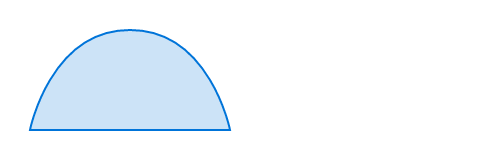
引数引数引数は関数への入力値です。関数名の後に括弧で囲んで指定します。
curve(fill:,,,)->How to fill the curve.
When setting a fill, the default stroke disappears. To create a rectangle with both fill and stroke, you have to configure both.
デフォルト値:none
fill-rule設定可能引数設定可能引数設定可能引数は、setルールを用いて設定でき、それ以降で使用するデフォルト値を変更できます。
fill-rulesetルールを用いて設定でき、それ以降で使用するデフォルト値を変更できます。The drawing rule used to fill the curve.
例を表示
// We use `.with` to get a new
// function that has the common
// arguments pre-applied.
#let star = curve.with(
fill: red,
curve.move((25pt, 0pt)),
curve.line((10pt, 50pt)),
curve.line((50pt, 20pt)),
curve.line((0pt, 20pt)),
curve.line((40pt, 50pt)),
curve.close(),
)
#star(fill-rule: "non-zero")
#star(fill-rule: "even-odd")
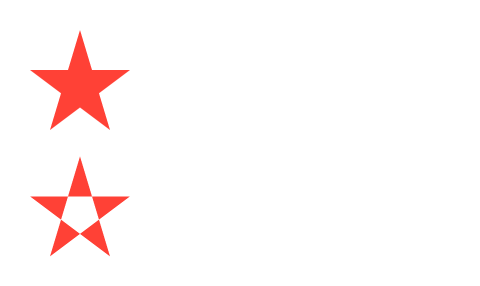
使用可能な文字列値
non-zeroSpecifies that "inside" is computed by a non-zero sum of signed edge crossings.
even-oddSpecifies that "inside" is computed by an odd number of edge crossings.
デフォルト値:"non-zero"
How to stroke the curve. This can be:
Can be set to none to disable the stroke or to auto for a
stroke of 1pt black if and if only if no fill is given.
例を表示
#let down = curve.line((40pt, 40pt), relative: true)
#let up = curve.line((40pt, -40pt), relative: true)
#curve(
stroke: 4pt + gradient.linear(red, blue),
down, up, down, up, down,
)

デフォルト値:auto
components必須引数必須引数必須引数は、関数を呼び出す際に必ず指定しなければなりません。位置引数位置引数位置引数は順序通りに指定することで、引数名を省略して設定できます。可変長引数可変長引数可変長引数は複数回指定することができます。
componentsThe components of the curve, in the form of moves, line and Bézier segment, and closes.
定義定義これらの関数や型には、関連する定義を持たせることができます。定義にアクセスするには、対象の関数や型の名前を指定した後に、ピリオド区切りで定義名を記述します。
move要素関数要素関数要素関数はsetルールやshowルールでカスタマイズできます。
movesetルールやshowルールでカスタマイズできます。Starts a new curve component.
If no curve.move element is passed, the curve will start at
(0pt, 0pt).
例を表示
#curve(
fill: blue.lighten(80%),
fill-rule: "even-odd",
stroke: blue,
curve.line((50pt, 0pt)),
curve.line((50pt, 50pt)),
curve.line((0pt, 50pt)),
curve.close(),
curve.move((10pt, 10pt)),
curve.line((40pt, 10pt)),
curve.line((40pt, 40pt)),
curve.line((10pt, 40pt)),
curve.close(),
)
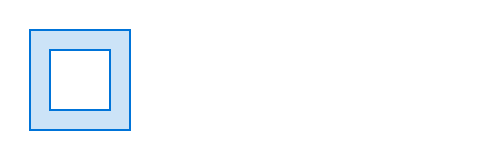
curve.move(,)->line要素関数要素関数要素関数はsetルールやshowルールでカスタマイズできます。
linesetルールやshowルールでカスタマイズできます。Adds a straight line from the current point to a following one.
例を表示
#curve(
stroke: blue,
curve.line((50pt, 0pt)),
curve.line((50pt, 50pt)),
curve.line((100pt, 50pt)),
curve.line((100pt, 0pt)),
curve.line((150pt, 0pt)),
)
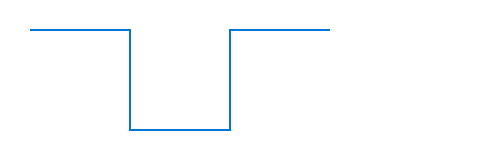
curve.line(,)->end
endThe point at which the line shall end.
relative設定可能引数設定可能引数設定可能引数は、setルールを用いて設定でき、それ以降で使用するデフォルト値を変更できます。
relativesetルールを用いて設定でき、それ以降で使用するデフォルト値を変更できます。Whether the coordinates are relative to the previous point.
例を表示
#curve(
stroke: blue,
curve.line((50pt, 0pt), relative: true),
curve.line((0pt, 50pt), relative: true),
curve.line((50pt, 0pt), relative: true),
curve.line((0pt, -50pt), relative: true),
curve.line((50pt, 0pt), relative: true),
)
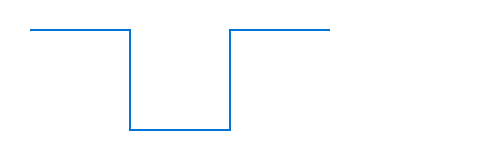
デフォルト値:false
quad要素関数要素関数要素関数はsetルールやshowルールでカスタマイズできます。
quadsetルールやshowルールでカスタマイズできます。Adds a quadratic Bézier curve segment from the last point to end, using
control as the control point.
例を表示
// Function to illustrate where the control point is.
#let mark((x, y)) = place(
dx: x - 1pt, dy: y - 1pt,
circle(fill: aqua, radius: 2pt),
)
#mark((20pt, 20pt))
#curve(
stroke: blue,
curve.move((0pt, 100pt)),
curve.quad((20pt, 20pt), (100pt, 0pt)),
)
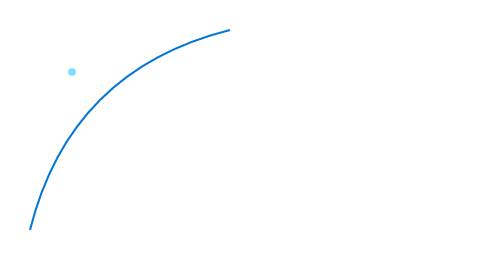
curve.quad(,,)->The control point of the quadratic Bézier curve.
- If
autoand this segment follows another quadratic Bézier curve, the previous control point will be mirrored. - If
none, the control point defaults toend, and the curve will be a straight line.
例を表示
#curve(
stroke: 2pt,
curve.quad((20pt, 40pt), (40pt, 40pt), relative: true),
curve.quad(auto, (40pt, -40pt), relative: true),
)

end
endThe point at which the segment shall end.
relative設定可能引数設定可能引数設定可能引数は、setルールを用いて設定でき、それ以降で使用するデフォルト値を変更できます。
relativesetルールを用いて設定でき、それ以降で使用するデフォルト値を変更できます。Whether the control and end coordinates are relative to the previous
point.
デフォルト値:false
cubic要素関数要素関数要素関数はsetルールやshowルールでカスタマイズできます。
cubicsetルールやshowルールでカスタマイズできます。Adds a cubic Bézier curve segment from the last point to end, using
control-start and control-end as the control points.
例を表示
// Function to illustrate where the control points are.
#let handle(start, end) = place(
line(stroke: red, start: start, end: end)
)
#handle((0pt, 80pt), (10pt, 20pt))
#handle((90pt, 60pt), (100pt, 0pt))
#curve(
stroke: blue,
curve.move((0pt, 80pt)),
curve.cubic((10pt, 20pt), (90pt, 60pt), (100pt, 0pt)),
)
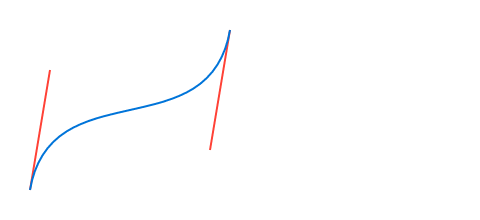
curve.cubic(,,,)->The control point going out from the start of the curve segment.
-
If
autoand this element follows anothercurve.cubicelement, the last control point will be mirrored. In SVG terms, this makescurve.cubicbehave like theSoperator instead of theCoperator. -
If
none, the curve has no first control point, or equivalently, the control point defaults to the curve's starting point.
例を表示
#curve(
stroke: blue,
curve.move((0pt, 50pt)),
// - No start control point
// - End control point at `(20pt, 0pt)`
// - End point at `(50pt, 0pt)`
curve.cubic(none, (20pt, 0pt), (50pt, 0pt)),
// - No start control point
// - No end control point
// - End point at `(50pt, 0pt)`
curve.cubic(none, none, (100pt, 50pt)),
)
#curve(
stroke: blue,
curve.move((0pt, 50pt)),
curve.cubic(none, (20pt, 0pt), (50pt, 0pt)),
// Passing `auto` instead of `none` means the start control point
// mirrors the end control point of the previous curve. Mirror of
// `(20pt, 0pt)` w.r.t `(50pt, 0pt)` is `(80pt, 0pt)`.
curve.cubic(auto, none, (100pt, 50pt)),
)
#curve(
stroke: blue,
curve.move((0pt, 50pt)),
curve.cubic(none, (20pt, 0pt), (50pt, 0pt)),
// `(80pt, 0pt)` is the same as `auto` in this case.
curve.cubic((80pt, 0pt), none, (100pt, 50pt)),
)
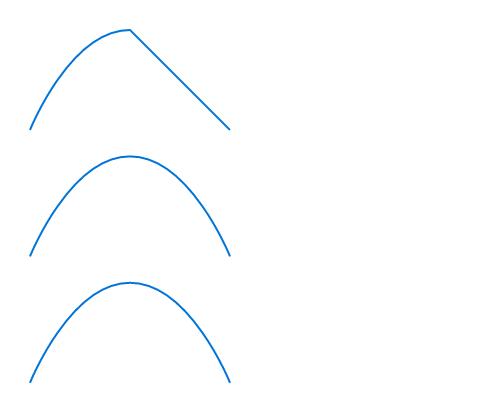
The control point going into the end point of the curve segment.
If set to none, the curve has no end control point, or equivalently,
the control point defaults to the curve's end point.
end
endThe point at which the curve segment shall end.
relative設定可能引数設定可能引数設定可能引数は、setルールを用いて設定でき、それ以降で使用するデフォルト値を変更できます。
relativesetルールを用いて設定でき、それ以降で使用するデフォルト値を変更できます。Whether the control-start, control-end, and end coordinates are
relative to the previous point.
デフォルト値:false
close要素関数要素関数要素関数はsetルールやshowルールでカスタマイズできます。
closesetルールやshowルールでカスタマイズできます。Closes the curve by adding a segment from the last point to the start of the
curve (or the last preceding curve.move point).
例を表示
// We define a function to show the same shape with
// both closing modes.
#let shape(mode: "smooth") = curve(
fill: blue.lighten(80%),
stroke: blue,
curve.move((0pt, 50pt)),
curve.line((100pt, 50pt)),
curve.cubic(auto, (90pt, 0pt), (50pt, 0pt)),
curve.close(mode: mode),
)
#shape(mode: "smooth")
#shape(mode: "straight")
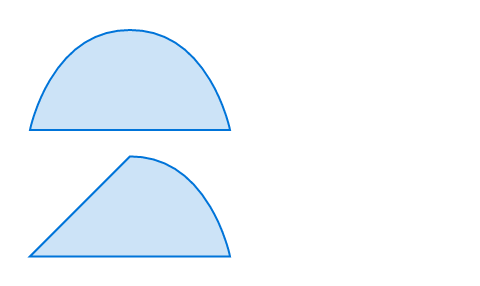
curve.close(mode:)->mode設定可能引数設定可能引数設定可能引数は、setルールを用いて設定でき、それ以降で使用するデフォルト値を変更できます。
modesetルールを用いて設定でき、それ以降で使用するデフォルト値を変更できます。How to close the curve.
使用可能な文字列値
smoothCloses the curve with a smooth segment that takes into account the control point opposite the start point.
straightCloses the curve with a straight line.
デフォルト値:"smooth"